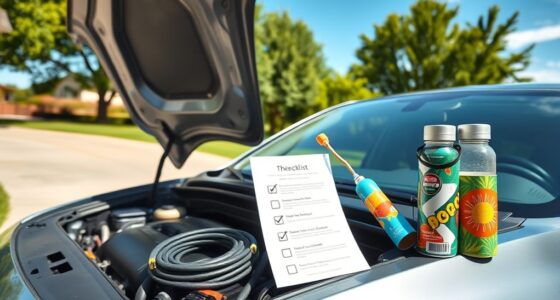If your headlights dim or your engine cranks slowly, it could be an early sign your battery is failing, especially before winter hits. Dashboard warning lights might turn on, and corrosion on terminals can hinder performance. Cold weather puts extra strain on your battery, so catching issues early helps prevent breakdowns when you need your vehicle most. Stay vigilant — more tips to keep your battery healthy are just ahead.
Key Takeaways
- Dim headlights and slow engine cranking indicate the battery is struggling to supply power.
- Dashboard warning lights may illuminate, signaling potential battery issues.
- Corrosion on terminals appears as white or greenish deposits, impairing electrical flow.
- Reduced battery performance is often noticeable during cold weather, causing starting difficulties.
- Regular battery testing and inspection can identify declining health before winter strains cause failure.

Batteries don’t fail overnight; they often show subtle signs of trouble early on. As winter approaches, it’s essential to pay attention to these signs so you can address issues before the cold weather makes starting your vehicle more difficult. One of the best ways to catch potential problems early is through regular battery testing. This process evaluates your battery’s overall health, including its capacity to hold a charge and deliver power when needed. If your battery test indicates reduced performance, it’s a clear sign that your battery may be nearing the end of its lifespan. Catching these warning signs early allows you to replace or service your battery in time, avoiding inconvenient breakdowns during winter’s coldest days.
Another critical step in maintaining a healthy battery is corrosion inspection. Over time, corrosion can develop around the battery terminals, often appearing as a white, ashy substance or greenish deposits. This corrosion hampers the flow of electricity, making it harder for your battery to deliver the power your vehicle needs, especially when the temperature drops. During corrosion inspection, you’ll want to check all the terminals and cables for buildup and clean them if necessary. Removing corrosion with a wire brush or a commercial terminal cleaner restores proper contact and improves overall battery performance. Preventing corrosion from forming in the first place can be achieved by applying a protective dielectric grease to the terminals after cleaning. Regular inspections of this kind are simple but effective in extending your battery’s lifespan and ensuring reliable starts when winter hits. Additionally, practicing preventative maintenance can significantly reduce the risk of unexpected battery failure.
You might also notice other early signs of battery trouble, such as dimming headlights, slow engine cranking, or a warning light on your dashboard. These symptoms often indicate that your battery is struggling to supply enough power. Don’t dismiss these signs—address them promptly through battery testing and corrosion inspection. These proactive measures help you identify issues before they turn into costly repairs or complete failures. When you combine regular testing with vigilant corrosion inspections, you’re taking essential steps to keep your vehicle reliable. Remember, cold weather puts extra strain on your battery, so the earlier you catch these signs, the better prepared you’ll be to handle winter’s challenges. Taking care of your battery now not only prolongs its life but also ensures peace of mind during the season when you need your vehicle most.
Frequently Asked Questions
Can Extreme Cold Weather Damage My Car Battery?
Extreme cold weather can indeed harm your car battery. Cold temperatures reduce battery capacity and make it harder for your battery to start your car. Additionally, cold weather can cause Battery corrosion, which further weakens the connection and performance. To prevent damage, check your battery regularly, keep terminals clean, and consider a battery warmer or insulation during harsh winter months. Proper maintenance helps ensure reliable starts in winter.
How Often Should I Check My Battery for Early Signs?
You should check your battery at least once a month during seasonal checks. Did you know that a battery can lose up to 35% of its capacity in just the first three years? Regular battery maintenance helps you catch early signs of failure, like slow engine starts or dim lights, before winter hits. Staying proactive guarantees your car stays reliable and prevents unexpected breakdowns when you need it most.
Do Battery Age and Usage Affect Failure Signs?
Yes, your battery’s age and usage considerably influence failure signs. As your battery gets older, corrosion can develop on terminals, and charging issues may become more frequent. Heavy usage drains the battery faster, leading to quicker wear and more noticeable problems. Regularly inspecting for corrosion and monitoring charging performance helps catch these issues early, ensuring your battery stays reliable, especially before winter when you need it most.
Are There Specific Symptoms Indicating a Failing Alternator?
Did you know that over 80% of alternator failures show warning signs early? You might notice unusual alternator noise or a dashboard warning light, both clear signs your alternator could be failing. If you hear grinding sounds or see dimming headlights, don’t ignore them. These symptoms indicate your alternator isn’t charging properly, risking you being stranded. Addressing these early signs promptly keeps your vehicle running smoothly and prevents costly repairs.
What Preventive Measures Can Extend My Battery’s Lifespan?
To extend your battery’s lifespan, focus on proper battery maintenance by regularly checking the terminals for corrosion and ensuring they’re clean and tight. Use correct charging techniques, such as avoiding overcharging or deep discharges, and consider using a smart charger. Additionally, keep your engine’s charging system in good shape and avoid short trips that prevent the battery from fully recharging. These steps help maintain ideal battery health year-round.
Conclusion
As winter approaches, you might notice subtle signs like slow engine starts or dimming headlights. These clues could be your car’s way of warning you about impending battery failure. Don’t ignore them—timing is everything. Imagine being stranded in freezing cold, unsure of why your car won’t start. Stay vigilant, get your battery checked early, and avoid the shock of being caught unprepared. The cold season’s surprises are easier to face when you’re one step ahead.









